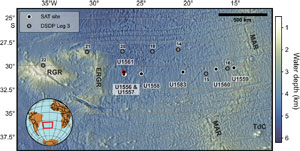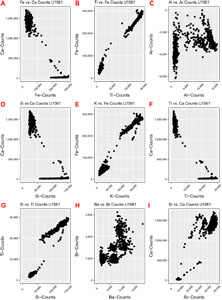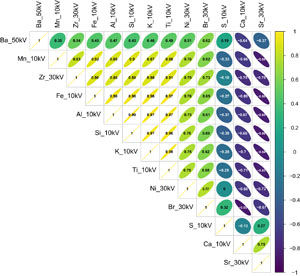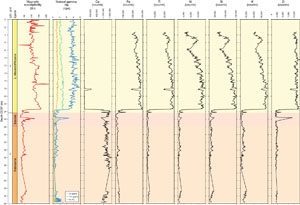Coggon, R.M., Teagle, D.A.H., Sylvan, J.B., Reece, J., Estes, E.R., Williams, T.J., Christeson, G.L., and the Expedition 390/393 Scientists
Proceedings of the International Ocean Discovery Program Volume 390/393
publications.iodp.org
https://doi.org/10.14379/iodp.proc.390393.207.2024
Data report: X-ray fluorescence scanning of sediment cores, IODP Expedition 390/393 Site U1561, South Atlantic Transect1
Claire M. Routledge,2 Chiara Amadori,2 Chiara Borrelli,2 Gail Christeson,2 Emily Estes,2 Laura Guertin,2 Jennifer Hertzberg,3 Michael R. Kaplan,2 Ravi Kiran Koorapati,4 Adriane R. Lam,2 Christopher M. Lowery,2 Andrew McIntyre,2 Julia Reece,2 Claudio Robustelli Test,2 Patricia Standring,5 Jason B. Sylvan,2 Mary Thompson,6 Alexandra Villa,2 Yi Wang,2 Shu Ying Wee,2 Trevor Williams,2 Jesse Yeon,6 Damon A.H. Teagle,2 Rosaline M. Coggon,2 and the Expedition 390/393 Scientists2
1 Routledge, C.M., Amadori, C., Borrelli, C., Christeson, G., Estes, E., Guertin, L., Hertzberg, J., Kaplan, M.R., Koorapati, R.K., Lam, A.R., Lowery, C.M., McIntyre, A., Reece, J., Robustelli Test, C., Standring, P., Sylvan, J.B., Thompson, M., Villa, A., Wang, Y., Wee, S.Y., Williams, T., Yeon, J., Teagle, D.A.H., Coggon, R.M., and the Expedition 390/393 Scientists, 2024. Data report: X-ray fluorescence scanning of sediment cores, IODP Expedition 390/393 Site U1561, South Atlantic Transect. In Coggon, R.M., Teagle, D.A.H., Sylvan, J.B., Reece, J., Estes, E.R., Williams, T.J., Christeson, G.L., and the Expedition 390/393 Scientists, South Atlantic Transect. Proceedings of the International Ocean Discovery Program, 390/393: College Station, TX (International Ocean Discovery Program). https://doi.org/10.14379/iodp.proc.390393.207.2024
2 Expedition 390/393 Scientists’ affiliations. Correspondence author: claire.routledge@ifg.uni-kiel.de
3 International Ocean Discovery Program, Texas A&M University, USA.
4 Binghamton University, United States.
5 University of Texas at Austin, United States.
6 Texas A&M University, United States.
Abstract
The western South Atlantic Ocean is a relatively understudied area of the world’s ocean, in part because of the lack of scientific ocean drilling and complete sedimentary sequences. During 2020–2022, a series of International Ocean Discovery Program Expeditions (390C, 395E, 390, and 393; South Atlantic Transect) sailed to this area, recovering material from the western flank of the Mid-Atlantic Ridge at a latitude of ~31°S. Here, we used X-ray fluorescence scanning of the sediment cores recovered and combined the data with shipboard magnetic susceptibility and natural gamma radiation to generate long-term geochemical records at Site U1561. These records enable us to document climatic and environmental perturbations on varying timescales and explore the paleoclimatic and paleoceanographic history of the western South Atlantic Ocean during the Cenozoic.
1. Introduction
The South Atlantic Transect (SAT) ocean drilling project comprised International Ocean Discovery Program (IODP) Expeditions 390 and 393, supported by engineering Expeditions 390C and 395E, and occupied a range of sites on the western Mid-Atlantic Ridge at ~31°S (Figure F1). This transect follows a slow/intermediate spreading rate Mid-Atlantic Ridge crustal flow line just south of the one that was originally spot cored during Deep Sea Drilling Program (DSDP) Leg 3, which provided direct evidence of seafloor spreading and support for the theory of plate tectonics (Maxwell et al., 1970). SAT expeditions recovered sedimentary successions at seven sites situated on ocean crust with ages of 7, 15, 31, 49, and 61 Ma (Sites U1556–U1561 and U1583). There is a dearth of deep-sea sediment records from the western South Atlantic, and the location of the SAT sites therefore provides an ideal opportunity for basin-wide comparison of Cenozoic paleoclimatology and paleoceanography (Coggon et al., 2024b).
IODP Site U1561 is situated in the western South Atlantic Ocean (30°43.2902′S, 26°41.7162′W) ~1250 km west of the Mid-Atlantic Ridge at a water depth of 4910 m. Site U1561 is located 24 km north of Site U1556 and sits on the same basement ridge; however, the elevation of the ridge shallows northward toward Site U1561, and the sediment cover is therefore significantly thinner than at Site U1556. Three holes were cored at Site U1561 during Expedition 395E. Holes U1561B and U1561C both missed the mudline because the site was shallower than predicted, and Hole U1561A recovered 47.9 m of sediment and 2.4 m of basement material. Because only Hole U1561A caught the mudline, no downhole continuous splice was constructed for this site. The sediments at Site U1561 are divided into two main lithologic units (Units I and II), which are composed of predominantly silty clay and calcareous nannofossil ooze, respectively. Shipboard biostratigraphy dates the sediment/basement interface at Site U1561 to the early Paleocene (61.2 Ma), which is similar in age to nearby Sites U1556 and U1557, which are located on 61.2 and 60.7 Ma crust, respectively.
We use high-resolution X-ray fluorescence (XRF) scanning of sediment cores from Site U1561 and across all SAT sites (Amadori et al., 2024; Lam et al., 2024; Lowery et al., 2024; Robustelli Test et al., 2024; Villa et al., 2024; Wang et al., 2024) to generate elemental composition of sediments through time in a nondestructive manner. Such data can provide information on sediment source and mode of transport and are often used for paleoclimate and paleoceanographic interpretations (e.g., Calvert and Pedersen, 2007; Croudace and Rothwell, 2015). Here, we present raw count data for all measured elements and highlight the relationships between elements commonly used in paleo research.
2. Methods and materials
All sediment archive halves from Hole U1561A were scanned in August 2022 on the fourth generation Avaatech XRF Core Scanner (XRF 2) at the IODP Gulf Coast Repository (GCR) at Texas A&M University in College Station, Texas (USA). The instrument is fitted with a water-cooled, 100 W rhodium side-window X-ray tube, a Brightspec SiriusSD silicon drift detector, and a Topaz-X high-resolution digital multichannel analyzer. XRF scans were acquired at three different voltages to measure different elements: 10 kV (with no filter) for major and minor elements (i.e., Al, Si, K, Ca, Ti, Mn, Fe, Cr, P, S, and possibly Mg), 30 kV (with a thick Pd filter) for heavier major and minor elements and geologically relevant trace elements (i.e., Ca, Ti, Mn, Fe, Ni, Sr, Rb, Zr, and Zn), and 50 kV (with a Cu filter) for heavier trace elements (i.e., Sr, Rb, Zr, and Ba). The cross-core and downcore slits were set to 12 and 10 mm, respectively. Count times were set to 6 s for the 10 and 30 kV scans and 10 s for the 50 kV scan. The current was set to 0.15, 1.24, and 0.75 mA for the 10, 30, and 50 kV scans, respectively. XRF data were collected every 5 cm; the first measurement was taken 5 cm below the top of the section, and the last point was measured as close as possible to the bottom of the section.
Prior to scanning, each core was removed from cold storage and brought to room temperature overnight. A glass microscope slide was used to clean the core surface. This was important to ensure all intervals had a flat surface for the scanner to read accurately and also to remove any mold that had grown. Care was taken not to move material stratigraphically up or down the core. The cores were then covered with 4 µm thick Ultralene plastic film to prevent contamination as the measuring prism moved along the core, which was affixed to the core liner to avoid air pockets forming under the film. To assess the core for cracks, uneven surfaces, or drilling disturbance, a 3D-printed replica of the scanning window was placed on the section and moved downcore. If a disturbance in the core surface was noted, the measurement spot was moved a few centimeters up or down the core (as close as possible to maintain target resolution) or skipped altogether if an alternative interval was not found.
For quality control purposes, standards were run at all three excitation levels at the start and end of scanning every day. At the start of the day, 20 replicates were run at each excitation level to ensure the machine was suitably warmed up; however, no replicates were run at the end of the day. Data were first processed from raw spectral peaks into peak areas and then exported into the Brightspec XRF spectral processing software bAxil as count data (counts per second) for each element. Erroneous data points were removed based on two main criteria: (1) throughput values <150,000 counts/s on the 10 kV scan and (2) samples with positive Ar values, with both indicating a gap between the sensor and the core. For continuity across sites of the SAT, data were run through an R script (available on GitHub at https://github.com/Ravikiran2316/IODP-Exp.-390-393-XRF) and invalid throughput and Ar values were removed.
3. Results
We produced crossplots of select elements (Figure F2) and carried out a Spearman’s rank correlation (Figure F3) to determine which elements correlate to each other, highlighting common elements used to interpret the source of marine sediments (i.e., terrigenous versus biogenic sediments) as well as elements often used for paleoclimate and paleoceanographic studies. The anticorrelation between Al and Ar highlights the effectiveness of the quality control applied to the data set because fewer negative Ar counts suggest air has been detected, and these data points have already been removed (Figure F2). At Site U1561, S, Ca, and Sr are negatively correlated to almost all elements (Figure F3). Relatively speaking, there is a strong negative correlation between Ca and Ba, Mn, Zr, Fe, Al, Si, K, Ti, Ni, and Br (ρ values range between −0.64 and −0.86) and a strong positive correlation between Ca and Sr (ρ = 0.75), where the latter is a relationship that is commonly used as a productivity indicator (Figure F3).
We plotted select element counts of Ca, Fe, Ti, Al, Si, K, and Zr against shipboard magnetic susceptibility (MS) and natural gamma radiation (NGR) (with U, Th, and K separated) (Figure F4). Measurements are plotted against depth in meters using the core composite depth below seafloor (CCSF) depth scale; however, because no downhole continuous splice exists for Site U1561, this is equivalent to the core depth below seafloor, Method B (CSF-B), depth scale, which has been corrected for expansion. We have also included shipboard sedimentological and age model data (Coggon et al., 2024a) to denote the lithologic units and major geologic epochs on the left of the graphs. Through the Late Miocene and Pliocene, MS, NGR, and elemental counts remain relatively stable with a noticeable peak in MS and Ca and a decrease in Fe, Ti, Al, Si, K, and Zr elemental counts at ~18 m CCSF.
There is a dramatic change in all measurements and counts at ~23 m CCSF that coincides with the Paleogene/Neogene boundary, which is relatively poorly constrained at this site because of the lack of calcareous microfossils in samples from Lithologic Unit I (i.e., silty clay) (Coggon et al., 2024a). MS, NGR, and all elements except Ca (which is anticorrelated) decrease significantly below this boundary (~23 m CCSF), marking the change in lithology from silty clay to calcareous nannofossil ooze (Coggon et al., 2024a). A peak in MS and NGR in the Eocene at ~26 m CCSF is most clearly picked up in the Zr element counts, and Ca exhibits a small decrease at the same depth.
Through the Paleocene, MS, NGR, and element counts remain relatively stable, with Ca displaying the most variation. Because of poor core recovery in Core 395E-U1561A-5H, a core gap exists between Cores 5H and 6H, and with no splice section available there is an interval between ~39 and 45 m CCSF where no data were recorded.
4. Data availability
All XRF core scanning data (at all three voltages) are accessible here in XRF in Supplementary material and will be permanently archived at PANGAEA (https://Pangea.de). The R Code used for quality control to remove spurious throughput and Ar values can be found on GitHub (https://github.com/Ravikiran2316/IODP-Exp.-390-393-XRF).
5. Acknowledgments
XRF scans reported here comprise the programmatic scanning for Expeditions 390C, 390, and 393 and were funded by the National Science Foundation (NSF) in agreement with the US Science Support Program (USSSP). We also acknowledge XRF scanning travel support for US scientists administered by USSSP, for German scientists provided by the German Research Foundation (DFG) IODP Priority Programme 527, and support of E.R. Estes and T.J. Williams through NSF award OCE1326927. We are grateful for the technicians and crew of JOIDES Resolution, without whom we would not have any cores to scan. We are also grateful to the staff of the GCR, especially Michelle Penkrot, and we would like to thank reviewer Larry Peterson.
References
Amadori, C., Borrelli, C., Christeson, G., Estes, E., Guertin, L., Hertzberg, J., Kaplan, M.R., Koorapati, R.K., Lam, A.R., Lowery, C.M., McIntyre, A., Reece, J., Robustelli Test, C., Routledge, C.M., Standring, P., Sylvan, J.B., Thompson, M., Villa, A., Wang, Y., Wee, S.Y., Williams, T., Yeon, J., Teagle, D.A.H., Coggon, R.M., and the Expedition 390/393 Scientists, 2024. Data report: X-ray fluorescence scanning of sediment cores, IODP Expedition 390/393 Site U1560, South Atlantic Transect. In Coggon, R.M., Teagle, D.A.H., Sylvan, J.B., Reece, J., Estes, E.R., Williams, T.J., Christeson, G.L., and the Expedition 390/393 Scientists, South Atlantic Transect. Proceedings of the International Ocean Discovery Program, 390/393: College Station, TX (International Ocean Discovery Program). https://doi.org/10.14379/iodp.proc.390393.205.2024
Calvert, S.E., and Pedersen, T.F., 2007. Elemental proxies for palaeoclimatic and palaeoceanographic variability in marine sediments: interpretation and application. In Hillaire–Marcel, C. and De Vernal, A. (Eds.), Developments in Marine Geology. 1: (Elsevier), 567–644. https://doi.org/10.1016/S1572-5480(07)01019-6
Coggon, R.M., Sylvan, J.B., Estes, E.R., Teagle, D.A.H., Reece, J., Williams, T.J., Christeson, G.L., Aizawa, M., Borrelli, C., Bridges, J.D., Carter, E.J., Dinarès-Turell, J., Estep, J.D., Gilhooly, W.P., III, Grant, L.C.J., Kaplan, M.R., Kempton, P.D., Lowery, C.M., McIntyre, A., Routledge, C.M., Slagle, A.L., Takada, M., Tamborrino, L., Wang, Y., Yang, K., Albers, E., Amadori, C., Belgrano, T.M., D’Angelo, T., Doi, N., Evans, A., Guérin, G.M., Harris, M., Hojnacki, V.M., Hong, G., Jin, X., Jonnalagadda, M., Kuwano, D., Labonte, J.M., Lam, A.R., Latas, M., Lu, W., Moal-Darrigade, P., Pekar, S.F., Robustelli Test, C., Ryan, J.G., Santiago Ramos, D., Shchepetkina, A., Villa, A., Wee, S.Y., Widlansky, S.J., Kurz, W., Prakasam, M., Tian, L., Yu, T., and Zhang, G., 2024a. Site U1561. In Coggon, R.M., Teagle, D.A.H., Sylvan, J.B., Reece, J., Estes, E.R., Williams, T.J., Christeson, G.L., and the Expedition 390/393 Scientists, South Atlantic Transect. Proceedings of the International Ocean Discovery Program, 390/393: College Station, TX (International Ocean Discovery Program). https://doi.org/10.14379/iodp.proc.390393.104.2024
Coggon, R.M., Teagle, D.A.H., Sylvan, J.B., Reece, J., Estes, E.R., Williams, T.J., Christeson, G.L., Aizawa, M., Albers, E., Amadori, C., Belgrano, T.M., Borrelli, C., Bridges, J.D., Carter, E.J., D'Angelo, T., Dinarès-Turell, J., Doi, N., Estep, J.D., Evans, A., Gilhooly, W.P., III, Grant, L.J.C., Guérin, G.M., Harris, M., Hojnacki, V.M., Hong, G., Jin, X., Jonnalagadda, M., Kaplan, M.R., Kempton, P.D., Kuwano, D., Labonte, J.M., Lam, A.R., Latas, M., Lowery, C.M., Lu, W., McIntyre, A., Moal-Darrigade, P., Pekar, S.F., Robustelli Test, C., Routledge, C.M., Ryan, J.G., Santiago Ramos, D., Shchepetkina, A., Slagle, A.L., Takada, M., Tamborrino, L., Villa, A., Wang, Y., Wee, S.Y., Widlansky, S.J., Yang, K., Kurz, W., Prakasam, M., Tian, L., Yu, T., and Zhang, G., 2024b. Expedition 390/393 summary. In Coggon, R.M., Teagle, D.A.H., Sylvan, J.B., Reece, J., Estes, E.R., Williams, T.J., Christeson, G.L., and the Expedition 390/393 Scientists, South Atlantic Transect. Proceedings of the International Ocean Discovery Program, 390/393: College Station, TX (International Ocean Discovery Program). https://doi.org/10.14379/iodp.proc.390393.101.2024
Croudace, I.W., and Rothwell, R.G. (Eds.), 2015. Micro-XRF Studies of Sediment Cores: Applications of a non-destructive tool for the environmental sciences: (Springer Dordrecht). https://doi.org/10.1007/978-94-017-9849-5
Lam, A.R., Amadori, C., Borrelli, C., Christeson, G., Estes, E., Guertin, L., Hertzberg, J., Kaplan, M.R., Koorapati, R.K., Lowery, C.M., McIntyre, A., Reece, J.S., Robustelli Test, C., Routledge, C.M., Standring, P., Sylvan, J.B., Thompson, M., Villa, A., Wang, Y., Wee, S.Y., Williams, T., Yeon, J., Teagle, D.A.H., Coggon, R.M., and the Expedition 390/393 Scientists, 2024. Data report: X-ray fluorescence scanning of sediment cores, IODP Expedition 390/393 Site U1583, South Atlantic Transect. In Coggon, R.M., Teagle, D.A.H., Sylvan, J.B., Reece, J., Estes, E.R., Williams, T.J., Christeson, G.L., and the Expedition 390/393 Scientists, South Atlantic Transect. Proceedings of the International Ocean Discovery Program, 390/393: College Station, TX (International Ocean Discovery Program). https://doi.org/10.14379/iodp.proc.390393.202.2024
Lowery, C.M., Amadori, C., Borrelli, C., Christeson, G., Estes, E., Guertin, L., Hertzberg, J., Kaplan, M.R., Koorapati, R.K., Lam, A.R., McIntyre, A., Reece, J., Robustelli Test, C., Routledge, C.M., Standring, P., Sylvan, J.B., Thompson, M., Villa, A., Wang, Y., Wee, S.Y., Williams, T., Yeon, J., Teagle, D.A.H., Coggon, R.M., and the Expedition 390/393 Scientists, 2024. Data report: X-ray fluorescence scanning of sediment cores, Site U1557, South Atlantic Transect. In Coggon, R.M., Teagle, D.A.H., Sylvan, J.B., Reece, J., Estes, E.R., Williams, T.J., Christeson, G.L., and the Expedition 390/393 Scientists, South Atlantic Transect. Proceedings of the International Ocean Discovery Program, 390/393: College Station, TX (International Ocean Discovery Program). https://doi.org/10.14379/iodp.proc.390393.201.2024
Maxwell, A.E., Von Herzen, R.P., Andrews, J.E., Boyce, R.E., Milow, E.D., Hsu, K.J., Percival, S.F., and Saito, T., 1970. Initial Reports of the Deep Sea Drilling Project, 3: Washington, DC (U.S. Government Printing Office). https://doi.org/10.2973/dsdp.proc.3.1970
Robustelli Test, C., Amadori, C., Borrelli, C., Christeson, G., Estes, E., Guertin, L., Hertzberg, J., Kaplan, M.R., Koorapati, R.K., Lam, A.R., Lowery, C.M., McIntyre, A., Reece, J., Routledge, C.M., Standring, P., Sylvan, J.B., Thompson, M., Villa, A., Wang, Y., Wee, S.Y., Williams, T., Yeon, J., Teagle, D.A.H., Coggon, R.M., and the Expedition 390/393 Scientists, 2024. Data report: X-ray fluorescence scanning of sediment cores, IODP Expedition 390/393 Site U1559, South Atlantic Transect. In Coggon, R.M., Teagle, D.A.H., Sylvan, J.B., Reece, J., Estes, E.R., Williams, T.J., Christeson, G.L., and the Expedition 390/393 Scientists, South Atlantic Transect. Proceedings of the International Ocean Discovery Program, 390/393: College Station, TX (International Ocean Discovery Program). https://doi.org/10.14379/iodp.proc.390393.204.2024
Routledge, C.M., Amadori, C., Borrelli, C., Christeson, G., Estes, E., Guertin, L., Hertzberg, J., Kaplan, M.R., Koorapati, R.K., Lam, A.R., Lowery, C.M., McIntyre, A., Reece, J., Robustelli Test, C., Standring, P., Sylvan, J.B., Thompson, M., Villa, A., Wang, Y., Wee, S.Y., Williams, T., Yeon, J., Teagle, D.A.H., Coggon, R.M., and the Expedition 390/393 Scientists, 2024. Supplementary material, https://doi.org/10.14379/iodp.proc.390393.207supp.2024. In Routledge, C.M., Amadori, C., Borrelli, C., Christeson, G., Estes, E., Guertin, L., Hertzberg, J., Kaplan, M.R., Koorapati, R.K., Lam, A.R., Lowery, C.M., McIntyre, A., Reece, J., Robustelli Test, C., Standring, P., Sylvan, J.B., Thompson, M., Villa, A., Wang, Y., Wee, S.Y., Williams, T., Yeon, J., Teagle, D.A.H., Coggon, R.M., and the Expedition 390/393 Scientists, Data report: X-ray fluorescence scanning of sediment cores, IODP Expedition 390/393 Site U1561, South Atlantic Transect. In Coggon, R.M., Teagle, D.A.H., Sylvan, J.B., Reece, J., Estes, E.R., Williams, T.J., Christeson, G.L., and the Expedition 390/393 Scientists, South Atlantic Transect. Proceedings of the International Ocean Discovery Program, 390/393: College Station, TX (International Ocean Discovery Program).
Ryan, W.B.F., Carbotte, S.M., Coplan, J.O., O’Hara, S., Melkonian, A., Arko, R., Weissel, R.A., Ferrini, V., Goodwillie, A., Nitsche, F., Bonczkowski, J., and Zemsky, R., 2009. Global multi-resolution topography synthesis. Geochemistry, Geophysics, Geosystems, 10(3):Q03014. https://doi.org/10.1029/2008GC002332
Villa, A., Amadori, C., Borrelli, C., Christeson, G., Estes, E., Guertin, L., Hertzberg, J., Kaplan, M.R., Koorapati, R.K., Lam, A.R., Lowery, C.M., McIntyre, A., Reece, J., Robustelli Test, C., Routledge, C.M., Standring, P., Sylvan, J.B., Thompson, M., Wang, Y., Wee, S.Y., Williams, T., Yeon, J., Teagle, D.A.H., Coggon, R.M., and the Expedition 390/393 Scientists, 2024. Data report: X-ray fluorescence scanning of sediment cores, IODP Expedition 390/393 Site U1558, South Atlantic Transect. In Coggon, R.M., Teagle, D.A.H., Sylvan, J.B., Reece, J., Estes, E.R., Williams, T.J., Christeson, G.L., and the Expedition 390/393 Scientists, South Atlantic Transect. Proceedings of the International Ocean Discovery Program, 390/393: College Station, TX (International Ocean Discovery Program). https://doi.org/10.14379/iodp.proc.390393.203.2024
Wang, Y., Amadori, C., Borrelli, C., Christeson, G., Estes, E., Guertin, L., Hertzberg, J., Kaplan, M.R., Koorapati, R.K., Lam, A.R., Lowery, C.M., McIntyre, A., Reece, J., Robustelli Test, C., Routledge, C.M., Standring, P., Sylvan, J.B., Thompson, M., Villa, A., Wee, S.Y., Williams, T., Yeon, J., and the Expedition 390/393 Scientists, 2024. Data report: X-ray fluorescence scanning of sediment cores, IODP Expedition 390/393 Site U1556, South Atlantic Transect. In Coggon, R.M., Teagle, D.A.H., Sylvan, J.B., Reece, J., Estes, E.R., Williams, T.J., Christeson, G.L., and the Expedition 390/393 Scientists, South Atlantic Transect. Proceedings of the International Ocean Discovery Program, 390/393: College Station, TX (International Ocean Discovery Program). https://doi.org/10.14379/iodp.proc.390393.206.2024



